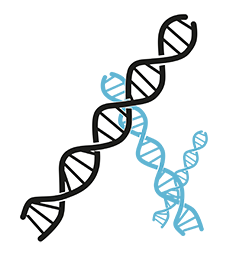Contact
Patrik Bohman, Environmental Monitoring and Assessment Analyst
Department of Aquatic Resources, Institute of Freshwater Research, SLU
patrik.bohman@slu.se, +46 10 478 42 17

Water contains fragments of DNA from fish, crayfish and mussels. Can a water sample show which species live in a lake? We test and develop the eDNA method as a complement to traditional environmental monitoring.
eDNA is short for "environmental DNA" and refers to the mixture of DNA fragments of organisms present in the water. eDNA can be anything from live animals, or animal parts such as eggs, sperm and larvae. DNA fragments of dead material such as feces, mucus, fish scale or free floating DNA molecules, can also be analyzed. The technology to be able to match the right organisms with DNA in a water sample has developed rapidly in recent years.
Genetic markers are used to detect aquatic species in water samples. With the help of species-specific primers and PCR we are able to detect very small amounts of DNA. When you need to detect several unknown species you can use metabarcoding. DNA-sequences is then matched to digital libraries of DNA sequences. This makes it possible to find different species in the field sample. The libraries have been expanded with 1000's of new species-specific DNA sequences.
There is every reason to develop simple and cost-effective eDNA-methodologies to detect aquatic species. Since 2008, when the first studies of eDNA in water samples were applied to invasive species, the interest for this type of methodology has increased nearly exponentially. This has resulted in partially reduced costs, more extensive use and further development of eDNA methods. The eDNA methodology can therefore add other elements to environmental monitoring, which traditional methods are lacking:
Despite all of these possibilities, eDNA leaves several questions unanswered:
eDNA, however, provides us with valuable and complementary data in today's environmental monitoring.
In the summer of 2018, the invasive species pumpkinseed sunfish (Lepomis gibbosus) was discovered in a pond at Kungsbacka in Halland County. A large number of reproductive individuals were found in the pond, as well as several live fish 1.5 km downstream. Therefore, there was an increased risk of spreading to nearby waters. SLU Aqua managed this project together with SeAnalytics AB in Gothenburg.
The pond at Kungsbacka was emptied by the landowner with supervision from the County Administrative Board in Halland a few weeks after the discovery.
Results from PCR-analyzes showed that the pumpkinseed sunfish were not detected in the water downstream the pond. However, several individuals were caught by electrofishing in September 2018, about 1.5 km downstream of the pond. Thus ther is still an increased risk that the species will spread further downstream and out into river Lillån and river Kungsbackaån.
Decisions to perform a possible follow-up of the results will be taken by the Swedish Agency for Marine and Water Management (SwAM).
This project has been published in SLU Aqua's report series (Aqua reports 2018:21 Jakten på solabborren (Lepomis gibbosus) - En eDNA-studie i Kungsbackaån).
The new manual “eDNA in a drop of water - Water sampling of DNA from fish, crayfish and mussels” describes how you practically track different species in freshwater from a water sample. The guide recommends methods, survey designs, how to write agreements with laboratories to analyze data. It also gives you guidance among different methods used today.
- It may feel like a jungle to choose method, or to keep up with what is needed to be done in an eDNA survey. That's why we have written this manual. I hope it will be useful in various projects, ”says Patrik Bohman at the Department of Aquatic Resources (SLU Aqua).
Today, serious efforts are being made to use eDNA as a method in environmental monitoring. Numerous scientific articles are published on the subject and many companies have begun to specialize in performing eDNA sampling and analysis. However, since no eDNA-standard yet exists and the different methods vary so much, it is difficult to find consistency when interpreting results from eDNA surveys. The quality also varies considerably in the reporting, and many studies may lack the possibility of scientific assessment.
As more and more people want to incorporate eDNA surveys in environmental monitoring, the following basic problems arise:
A possible way forward is therefore to gather independent experts, authorities and financiers to define quality standards. Then the same processes should be performed as for other contracts, which means that independent laboratories are allowed to analyze the same samples and make a comparison to see how robust and replicable the methods are.
Welcome to the Crayfish eDNA workshop! | Externwebben (slu.se) Register before April 23. The crayfish & eDNA workshop at Drottningholm in Stockholm! The main topic during three days in May is how to improve detection of crayfish and crayfish plague from water samples by using eDNA methodology.
Patrik Bohman, Environmental Monitoring and Assessment Analyst
Department of Aquatic Resources, Institute of Freshwater Research, SLU
patrik.bohman@slu.se, +46 10 478 42 17
Fish, crayfish and mussels as eDNA in environmental monitoring